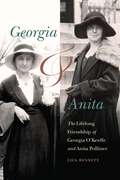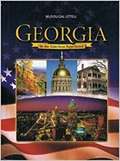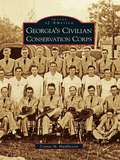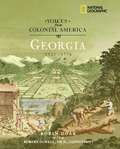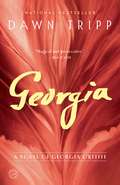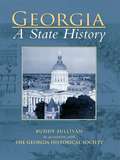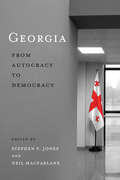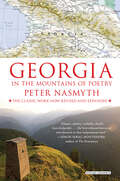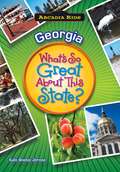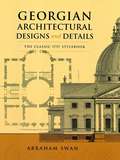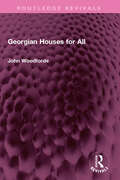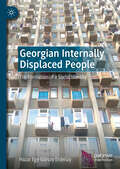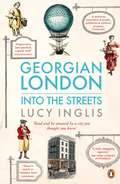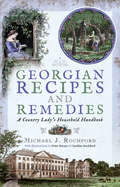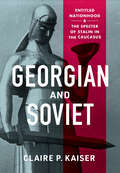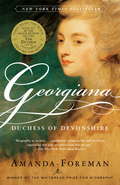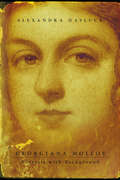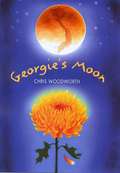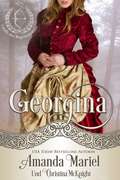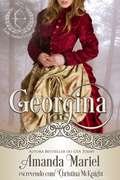- Table View
- List View
Georgia and Anita: The Lifelong Friendship of Georgia O'Keeffe and Anita Pollitzer
by Liza BennettGeorgia O&’Keeffe knew as soon as she met Anita Pollitzer that they had nothing in common. Anita looked like a china doll, small boned and delicate, and obviously well-to-do in her fashionable tunics and hobble skirts. She had the kind of mouth that settled naturally into a smile, which irritated O&’Keeffe, who had no time for dewy-eyed girls. Yet this first impression was the beginning of a lifelong friendship that had a tremendous impact on both women and on twentieth-century America. In Georgia and Anita Liza Bennett tells the little-known story of their enduring friendship and its ultimately tragic arc. It was Pollitzer who first showed O&’Keeffe&’s work to family friend and mentor Alfred Stieglitz, the world-famous photographer whose 291 Gallery in New York City was the epicenter of the modern art world. While O&’Keeffe, Stieglitz, and their circle of friends were at the forefront of American modernism, Pollitzer became a leader of the National Woman&’s Party and was instrumental in the passage of the Nineteenth Amendment, guaranteeing women the right to vote. Based on extensive research, including their fifty-year correspondence, Georgia and Anita casts light on the friendship of these two women who, in different ways, helped to modernize the world and women&’s roles in it. For more information about Georgia and Anita, visit georgiaandanita.com.
Georgia and the American Experience
by Bonnie Bullard LondonThis textbook on Georgia explores the history and geography of Georgia and includes in Appendix: Georgia Vital Statistics, Georgia Counties, Georgia Governors, Georgia Colleges and Universities, and Georgia Atlas.
Georgia in the American Experience (McDougal Littell Georgia State American History Ser.)
by Patricia Klein Craig PascoeGeorgia in the American Experience
Georgia's Civilian Conservation Corps
by Connie M. HuddlestonAt a time when our country struggled with a deep financial depression, the United States began to see incredible numbers of men and women who could not find work. During the first days of his administration, Pres. Franklin D. Roosevelt sought to create opportunities for this country's uneducated and undereducated young men to find work, help support their families, and receive training in a variety of fields. President Roosevelt's own vision brought about the Civilian Conservation Corps (CCC). Images of America: Georgia's Civilian Conservation Corps examines the role these young men played in developing three national forests, three national monuments, a national battlefield, 10 state parks, and four military installations. This book illustrates and gives voice to the CCC's rich contribution to Georgia's landscape and history and allows us to understand how the creation of this social employment program was once seen as the shining example of FDR's New Deal.
Georgia, 1521-1776 (National Geographic Voices From Colonial America)
by Robert Olwell Robin Santos DoakDid you know that the treasure of the infamous pirate Blackbeard is probably buried on one of the islands off Georgia? And did you know of the dastardly deed of Spanish privateers that provoked the War of Jenkins's Ear? <p><p> James Oglethorpe's "noble experiment" to make Georgia a place where debtors got a second chance and slavery and alcohol were banned was destroyed by "malcontents." Plantations producing rice and indigo increased the demand for slave labor, and the rift between the coastal planters and poorer upcountry farmers quickly divided the colony. This division would also complicate Georgia's decision to join the other colonies in the fight for independence.
Georgia: A Novel of Georgia O'Keeffe
by Dawn TrippNATIONAL BESTSELLER * In a dazzling work of historical fiction in the vein of Nancy Horan's Loving Frank, Dawn Tripp brings to life Georgia O'Keeffe, her love affair with photographer Alfred Stieglitz, and her quest to become an independent artist. This is not a love story. If it were, we would have the same story. But he has his, and I have mine. In 1916, Georgia O'Keeffe is a young, unknown art teacher when she travels to New York to meet Stieglitz, the famed photographer and art dealer, who has discovered O'Keeffe's work and exhibits it in his gallery. Their connection is instantaneous. O'Keeffe is quickly drawn into Stieglitz's sophisticated world, becoming his mistress, protégé, and muse, as their attraction deepens into an intense and tempestuous relationship and his photographs of her, both clothed and nude, create a sensation. Yet as her own creative force develops, Georgia begins to push back against what critics and others are saying about her and her art. And soon she must make difficult choices to live a life she believes in.A breathtaking work of the imagination, Georgia is the story of a passionate young woman, her search for love and artistic freedom, the sacrifices she will face, and the bold vision that will make her a legend.Praise for Georgia"Complex and original . . . Georgia conveys O'Keeffe's joys and disappointments, rendering both the woman and the artist with keenness and consideration."--The New York Times Book Review"As magical and provocative as O'Keeffe's lush paintings of flowers that upended the art world in the 1920s . . . Tripp inhabits Georgia's psyche so deeply that the reader can practically feel the paintbrush in hand as she creates her abstract paintings and New Mexico landscapes. . . . Evocative from the first page to the last, Tripp's Georgia is a romantic yet realistic exploration of the sacrifices one of the foremost artists of the twentieth century made for love."--USA Today "Sexually charged . . . insightful . . . Dawn Tripp humanizes an artist who is seen in biographies as more icon than woman. Her sensuous novel is as finely rendered as an O'Keeffe painting."--The Denver Post"A vivid work forged from the actual events of O'Keeffe's life . . . [Tripp] imbues the novel with a protagonist who forces the reader to consider the breadth of O'Keeffe's talent, business savvy, courage and wanderlust. . . . [She] is vividly alive as she grapples with success, fame, integrity, love and family."--Salon "Masterful . . . The book is a lovely portrayal of an iconic artist who is independent and multidimensional. Tripp's O'Keeffe is a woman hoping to break free of conventional definitions of art, life and gender, as well as a woman of deep passion and love."--Milwaukee Journal Sentinel "O'Keeffe blazes across the pages in Tripp's tour de force about this indomitable woman. . . . Tripp has hit her stride here, bringing to life one of the most remarkable artists of the twentieth century with veracity, heart, and panache."--Publishers Weekly (starred review)"I devoured this dazzling novel about an American icon. Dawn Tripp brings Georgia O'Keeffe so fully to life on every page and, with great wisdom, examines the very nature of love, longing, femininity, and art."--J. Courtney Sullivan, New York Times bestselling author of Maine and The EngagementsFrom the Hardcover edition.
Georgia: A State History (The\making Of America Ser.)
by Buddy Sullivan Georgia Historical SocietyGeorgia's past has diverged from the nation's and given the state and its people a distinctive culture and character. Some of the best, and the worst, aspects of American and Southern history can be found in the story of what is arguably the most important state in the South. Yet just as clearly Georgia has not always followed the road traveled by the rest of the nation and the region. Explaining the common and divergent paths that make us who we are is one reason the Georgia Historical Society has collaborated with Buddy Sullivan and Arcadia Publishing to produce Georgia: A State History, the first full-length history of the state produced in nearly a generation. Sullivan's lively account draws upon the vast archival and photographic collections of the Georgia Historical Society to trace the development of Georgia's politics, economy, and society and relates the stories of the people, both great and small, who shaped our destiny. This book opens a window on our rich and sometimes tragic past and reveals to all of us the fascinating complexity of what it means to be a Georgian.
Georgia: From Autocracy to Democracy (Thirdworlds Ser.)
by Stephen F. Jones Neil MacFarlaneReflecting on the deep and complex changes in Georgian politics over the last quarter of a century, this book highlights the domestic and international developments that have shaped Georgia as a state and society. Georgia: From Autocracy to Democracy covers a wide array of topics, including the economy, elections, judicial and educational systems, relations with the European Union, and Georgia’s interaction with its regional neighbours, including Russia, Turkey, and Iran. In the book, Georgian policy-makers, practitioners, and scholars who have worked in the administration, in the opposition, in the Third Sector, and in academia provide first-hand perspectives on Georgia’s political and economic life. They demonstrate exceptional insight into the extraordinary transformations in Georgia over the last twenty-five years, from the authoritarianism of President Zviad Gamsakhurdia, through the experience of civil war in the 1990s, to democracy today.
Georgia: In the Mountains of Poetry (Caucasus World: Peoples Of The Caucasus Ser.)
by Peter Nasmyth&“Elegiac, quirky, readable, deeply knowledgeable . . . The best cultural-historical introduction to that tempestuous land,&” the Georgian republic. (Simon Sebag Montefiore, author of The Romanovs) Georgia has been called the world&’s most beautiful country, yet little is known about it beyond its borders. This topical and vital book by Peter Nasmyth, the &“ideal chronicler&” (Literary Review) is the much-celebrated introduction to Georgia&’s remarkable people, landscape, and culture. Over its 3,000-year-old history, Georgia has been ruled by everyone from the Greeks to the Ottomans, became a coveted part of the Russian Empire for a hundred years, and was incorporated into the Soviet Union in 1921. Since gaining independence in 1991, Georgia has undergone a dramatic socioeconomical and political transformation, and although its political situation remains precarious, Georgia&’s strong sense of nationhood has reinvigorated the country. Vivid and comprehensive, Nasmyth&’s Georgia: In the Mountains of Poetry is a unique eyewitness account of Georgia&’s rebirth and creates an unforgettable portrait of its remarkable landscape, history, people and culture. Offering fascinating insights into the life of ordinary and high profile Georgians, it is essential reading for anyone who wants to know more of this astonishing place. &“The best book on post-Soviet Georgia . . . Nasmyth is prepared to take risks―hanging out with mafiosi and walking through minefields to reach that part of western Georgia that has bloodily seceded . . . a riveting portrait . . . powerfully evocative.&” —Independent &“It would be difficult to read Nasmyth's quirky, entertaining, informative, sometimes surreal book without having an impulse to ring a travel agent and ask for flights to Tblisi.&” —LiteraryReview
Georgia: What's So Great About This State?
by Kate Boehm JeromeWHY does the land in the Okefenokee Swamp seems to move? WHAT threatened the entire Georgia cotton business in the early 1920s? Find these answers and more in the Georgia edition of What's So Great About This State?
Georgian Architectural Designs and Details: The Classic 1757 Stylebook
by Abraham SwanAmong the 18th century's most influential architectural designers and writers, Abraham Swan defined many conventions of English rococo detail. This reprint of an extremely rare and classic stylebook, compiled by the English architect nearly 250 years ago, provides outstanding examples of Palladian and Georgian architecture and design in colonial America and England.Included are floor plans, detailed elevations, and drawings for cornices, mouldings, and other decorative elements that demonstrate Swan's unique style. Designed, in his words, more for "Gentlemen of moderate Fortunes than of great Estates who may be inclined to build Houses," Swan's designs featured such aesthetic touches as double staircases, elegant entryways, and two or three floors with spacious galleries, salons, and dressing rooms.Invaluable to architectural historians and designers, this splendid stylebook will delight devotees of early English Georgian and American domestic architecture and interior design, cultural historians, artists, and craftworkers.
Georgian Houses for All (Routledge Revivals)
by John WoodfordeFirst published in 1978, Georgian Houses for All describes how little Gregorian houses came into being and how the original inhabitants used them. Gregorian houses at their smallest and simplest can be seen everywhere in the British Isles – detached, semi-detached and joined together in terraces. There are probably still over a million of them, built during a period of 130 years without the direct aid of architects. John Woodforde points out that an instinctive wish for a symmetrical front seems to be shown by young children’s drawings of houses, these being generally balanced and orderly. The Georgians’ love of symmetry, marked in their way of hanging pictures, was part of a desire for private order amongst public disorder, a desire to have one small sphere in which nature was fully controlled. John Woodforde reminds us that, in the present-day return to terrace-house building, the Georgian version remains a valuable guide. The book will be of interest to students of architecture, urban planning, and history.
Georgian Internally Displaced People: The Formation of a Social Identity
by Hazar Ege Gürsoy ErdenayThis book explores the construction of Internally Displaced Persons (IDPs) identity as a social group in Georgia, framed through Tajfel and Turner's Social Identity Theory. It examines the key factors shaping the identity of Georgian IDPs displaced by ethnic conflicts in two major migration waves (the early 1990s and 2008) from Abkhazia and South Ossetia. Divided into two parts, the study first looks at the historical context of the ethnic conflicts and the state's responses to displacement. The second part focuses on the formation of IDP identity, analyzing how external definitions by the host community have perpetuated devaluation? throughout the post-Soviet period. It also highlights the self-perceptions, characteristics and tactics that have helped transform IDP identity from a devalued label to a more positive and resilient social identity.
Georgian London: Into the Streets
by Lucy InglisIn Georgian London: Into the Streets, Lucy Inglis takes readers on a tour of London's most formative age - the age of love, sex, intellect, art, great ambition and fantastic ruin. Travel back to the Georgian years, a time that changed expectations of what life could be. Peek into the gilded drawing rooms of the aristocracy, walk down the quiet avenues of the new middle class, and crouch in the damp doorways of the poor. But watch your wallet - tourists make perfect prey for the thriving community of hawkers, prostitutes and scavengers. Visit the madhouses of Hackney, the workshops of Soho and the mean streets of Cheapside. Have a coffee in the city, check the stock exchange, and pop into St Paul's to see progress on the new dome.This book is about the Georgians who called London their home, from dukes and artists to rent boys and hot air balloonists meeting dog-nappers and life-models along the way. It investigates the legacies they left us in architecture and art, science and society, and shows the making of the capital millions know and love today.'Read and be amazed by a city you thought you knew' Jonathan Foyle, World Monuments Fund'Jam-packed with unusual insights and facts. A great read from a talented new historian' Independent'Pacy, superbly researched. The real sparkle lies in its relentless cavalcade of insightful anecdotes . . . There's much to treasure here' Londonist'Inglis has a good ear for the outlandish, the farcical, the bizarre and the macabre. A wonderful popular history of Hanoverian London' London Historians
Georgian Recipes and Remedies: A Country Lady's Household Handbook
by Michael J. Rochford&“A brilliant collection of recipes, receipts, restoratives and remarkable cures from the Georgian era . . . a joy to read out to your friends and family.&” —Books Monthly Discover the recipes for Mrs. Rooke&’s Very Good Plum Cake and Lady Harbord&’s Marigold Cheese. Learn how to preserve gooseberries &“as green as they grow&” and make Sir Theodore Colladon&’s Peach Flower Syrup. Feast on Lady St. Quintin&’s Dutch Pudding and Mrs. Eall&’s Candied Cowslips. Then wash it all down with Lady Strickland&’s Strong Mead or some Right Red Dutch Currant Wine. These are just some of the delightful Georgian recipes found in the receipt books of Sabine Winn, the eighteenth-century Swiss-born wife of Sir Rowland Winn, 5th Baronet Nostell of the impressive Palladian mansion, Nostell Priory in Yorkshire. Using centuries-old cookbooks, newspaper clippings, old family recipes and contributions from noble friends, Lady Winn created a wonderfully eclectic collection of mouthwatering dishes that are presented in this new volume for modern readers to enjoy. Mistrustful of English doctors, Sabine&’s receipt books also contain scores of remedies for a whole series of complaints, such as: The Best Thing in the World for Languishing Spirits or Fatigue after a Journey; Mrs Aylott&’s Excellent Remedy for Colic; Aunt Barrington&’s Cure for Pleurisy; An Approved Medicine to Drive the Scurvy or any other Ill Humour out of a Man&’s Body; and A Diet Drink to Cure all Manner of Hurts and Wounds.&“I found the herbal use in the recipes intriguing, creative, and sometimes delightfully odd . . . provides an interesting slice of 18th century Georgian life in England.&” —American Herb Association Quarterly
Georgian Recipes and Remedies: A Country Lady's Household Handbook
by Michael J. Rochford&“A brilliant collection of recipes, receipts, restoratives and remarkable cures from the Georgian era . . . a joy to read out to your friends and family.&” —Books Monthly Discover the recipes for Mrs. Rooke&’s Very Good Plum Cake and Lady Harbord&’s Marigold Cheese. Learn how to preserve gooseberries &“as green as they grow&” and make Sir Theodore Colladon&’s Peach Flower Syrup. Feast on Lady St. Quintin&’s Dutch Pudding and Mrs. Eall&’s Candied Cowslips. Then wash it all down with Lady Strickland&’s Strong Mead or some Right Red Dutch Currant Wine. These are just some of the delightful Georgian recipes found in the receipt books of Sabine Winn, the eighteenth-century Swiss-born wife of Sir Rowland Winn, 5th Baronet Nostell of the impressive Palladian mansion, Nostell Priory in Yorkshire. Using centuries-old cookbooks, newspaper clippings, old family recipes and contributions from noble friends, Lady Winn created a wonderfully eclectic collection of mouthwatering dishes that are presented in this new volume for modern readers to enjoy. Mistrustful of English doctors, Sabine&’s receipt books also contain scores of remedies for a whole series of complaints, such as: The Best Thing in the World for Languishing Spirits or Fatigue after a Journey; Mrs Aylott&’s Excellent Remedy for Colic; Aunt Barrington&’s Cure for Pleurisy; An Approved Medicine to Drive the Scurvy or any other Ill Humour out of a Man&’s Body; and A Diet Drink to Cure all Manner of Hurts and Wounds.&“I found the herbal use in the recipes intriguing, creative, and sometimes delightfully odd . . . provides an interesting slice of 18th century Georgian life in England.&” —American Herb Association Quarterly
Georgian and Soviet: Entitled Nationhood and the Specter of Stalin in the Caucasus
by Claire P. KaiserGeorgian and Soviet investigates the constitutive capacity of Soviet nationhood and empire. The Soviet republic of Georgia, located in the mountainous Caucasus region, received the same nation-building template as other national republics of the USSR. Yet Stalin's Georgian heritage, intimate knowledge of Caucasian affairs, and personal involvement in local matters as he ascended to prominence left his homeland to confront a distinct set of challenges after his death in 1953.Utilizing Georgian archives and Georgian-language sources, Claire P. Kaiser argues that the postwar and post-Stalin era was decisive in the creation of a "Georgian" Georgia. This was due not only to the peculiar role played by the Stalin cult in the construction of modern Georgian nationhood but also to the subsequent changes that de-Stalinization wrought among Georgia's populace and in the unusual imperial relationship between Moscow and Tbilisi. Kaiser describes how the Soviet empire could be repressive yet also encourage opportunities for advancement—for individual careers as well as for certain nationalities. The creation of national hierarchies of entitlement could be as much about local and republic-level imperial imaginations as those of a Moscow center.Georgian and Soviet reveals that the entitled, republic-level national hierarchies that the Soviet Union created laid a foundation for the claims of nationalizing states that would emerge from the empire's wake in 1991. Today, Georgia still grapples with the legacies of its Soviet century, and the Stalin factor likewise lingers as new generations of Georgians reevaluate the symbiotic relationship between Soso Jughashvili and his native land.
Georgiana
by Amanda ForemanThe winner of Britain's prestigious Whitbread Prize and a bestseller there for months, this wonderfully readable biography offers a rich, rollicking picture of late-eighteenth-century British aristocracy and the intimate story of a woman who for a time was its undisputed leader.Lady Georgiana Spencer was the great-great-great-great-aunt of Diana, Princess of Wales, and was nearly as famous in her day. In 1774, at the age of seventeen, Georgiana achieved immediate celebrity by marrying one of England's richest and most influential aristocrats, the Duke of Devonshire. Launched into a world of wealth and power, she quickly became the queen of fashionable society, adored by the Prince of Wales, a dear friend of Marie-Antoinette, and leader of the most important salon of her time. Not content with the role of society hostess, she used her connections to enter politics, eventually becoming more influential than most of the men who held office. Her good works and social exploits made her loved by the multitudes, but Georgiana's public success, like Diana's, concealed a personal life that was fraught with suffering. The Duke of Devonshire was unimpressed by his wife's legendary charms, preferring instead those of her closest friend, a woman with whom Georgiana herself was rumored to be on intimate terms. For over twenty years, the three lived together in a jealous and uneasy ménage à trois, during which time both women bore the Duke's children--as well as those of other men.Foreman's descriptions of Georgiana's uncontrollable gambling, all- night drinking, drug taking, and love affairs with the leading politicians of the day give us fascinating insight into the lives of the British aristocracy in the era of the madness of King George III, the American and French revolutions, and the defeat of Napoleon. A gifted young historian whom critics are already likening to Antonia Fraser, Amanda Foreman draws on a wealth of fresh research and writes colorfully and penetratingly about the fascinating Georgiana, whose struggle against her own weaknesses, whose great beauty and flamboyance, and whose determination to play a part in the affairs of the world make her a vibrant, astonishingly contemporary figure.
Georgiana Molloy: Portrait with Background
by Alexandra HasluckThe story of a remarkable pioneer who discovered in the strange colonial wilderness the splendour and richness of Australia's unique flora. In 1829 Georgiana Molloy moved from the middle-class comfort of the English border country to an isolated wilderness on the opposite side of the world. The young bride and her husband, Captain John Molloy, were among a small party that founded the settlement of Augusta on Western Australia's south-west coast. A pioneer of great courage and capacity, Georgiana was presented with seemingly overwhelming trials and hardships. But she was a woman who was never defeated by circumstance, and never ceased to find enjoyment and satisfaction in her life. One of her enduring legacies is her study and identification of much of the unique local flora. A vivid portrait of an extraordinary woman.
Georgie's Moon
by Chris WoodworthGeorgie Collins knows exactly how to make it through life in a new town. Before her father left for Vietnam, he gave her standing orders never to let anyone mess with her, and she won't. As long as she doesn't allow the enemy to smell her fear, Georgie will survive seventh grade in Glendale, Indiana, just fine. But that doesn't mean she'll like it. How could she? Her school has forced her to participate in a "Good Deeds Program," so she's stuck visiting old people in a nursing home.What's more, her classes are filled with "peacenik" kids who think the war is wrong - including her only friend. At home,it seems that the kids her mom is babysitting are constantly whining at her. Worst of all, Georgie's father has been gone a long time - and even though he promised to send her his love every night on the moon, sometimes that's not enough. This story of a feisty girl's fierce devotion to her father is a powerful reflection on the ravages of war.
Georgina
by Amanda Mariel Christina BergmannEine starke junge Frau … Lady Georgina Setons Zukunftspläne sind wie sie – wild und verwegen. Der Liebeskummer ihrer Vergangenheit treibt sie an. Denn sie will ihr Ziel um jeden Preis erreichen … und ihr Schicksal selbst in die Hand nehmen. Kann sie sich als beste Bogenschützin Englands beweisen und so ihre Zukunft als unabhängige Frau sichern? Ein ehrgeiziger Mann … Er ist zwar nur der zweitgeborene Sohn des Viscounts, doch das hält Felton Crauford nicht davon ab, seine eigene Zukunft zu planen und Reichtum zu erarbeiten. Zunächst scheint ihm das Glück hold, als er ein reiches Mineralvorkommen entdeckt. Doch die Ader verläuft von seinem auf ein benachbartes Grundstück. Zu seinem Ärger kommt ihm der dort lebende Wildfang immer wieder in die Quere. Zu allem Überfluss ist aus dem kleinen nervigen Mädchen nun eine wunderschöne Frau geworden, deren Reize er nicht ignorieren kann. Felton und Georgina kämpfen beide gegen ein unbezwingbares Verlangen an. Ihm nachzugeben würde ihrer beide Pläne zunichtemachen. Dennoch sind sie hilflos ihren Gefühlen füreinander ausgeliefert. Georgina muss sich entscheiden: Verschenkt sie ihr Herz noch ein weiteres Mal oder wird sie alles verlieren?
Georgina (Lady Archer's Creed Ser.)
by Éli Assunção Amanda MarielUma mulher determinada… Selvagem e irresponsável, Lady Georgina Seton tem planos para o seu futuro. Conduzida pela dor de um coração partido, fará o que quer que seja necessário para atingir seus objetivos… e ela está determinada a controlar o próprio destino. Ao se tornar a melhor arqueira que a Inglaterra já viu, conseguirá garantir seu futuro sem ter que se casar. Um homem ambicioso... Nascido sobressalente, Felton Crauford está inclinado a garantir o seu futuro acumulando riquezas. O veio mineral que descobre prometeu ser uma bênção, mas há um problema... a reserva segue para a propriedade vizinha. Para seu desespero, a moleca que mora ao lado faz qualquer coisa que pode para se meter em seu caminho. Tudo isso enquanto se prova uma tentação que ele não pode simplesmente ignorar. Felton e Georgina são apanhados em um anseio incontrolável que ameaça destruir os planos de ambos. Pior, eles são incapazes de controlar o desejo que arde entre eles. Georgina deve fazer suas apostas: Abrir seu coração uma vez mais ou se arriscar a perder tudo.
